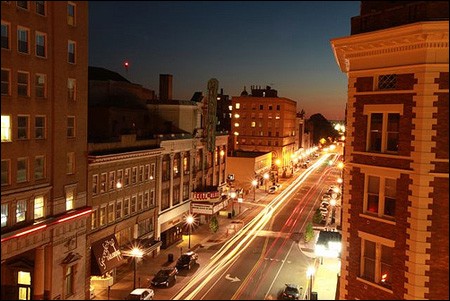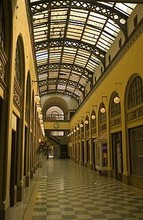Huntington Arcade
Introduction
Text-to-speech Audio
Images
The outside of the old Huntington Arcade, located in-between The First State Bank and the Keither Albee.

The inside of the renovated Galleria, which retains its glass ceiling and open arcade design. Developers hope the renovated building will become a center of economic development and a desired residential property.

Backstory and Context
Text-to-speech Audio
Shopping arcades were structures containing commercial spaces and were characterized by their enclosed passageways, which linked the businesses together. Arcades were prevalent for centuries in Europe and were commonplace in the United States during the early twentieth century. The Ritter family of Huntington constructed an arcade on Fourth Avenue in 1925. The two-story structure featured elements of Italianate and Renaissance Revival style architecture. It was particularly noteworthy for its ornate interior and glass ceiling. The facility was known variously as the Huntington Arcade, the Ritter Arcade, or the Bank Arcade, as it was located adjacent to First Huntington National Bank.
The arcade was one of the most prominent commercial centers in downtown Huntington for decades. The first floor contained retail shops while the second floor housed offices for doctors and other professionals. A bowling alley, Arcade Lanes, operated in the basement from the 1920s until 1976. The oldest and most well-known business was the Peanut Shoppe. It originally opened in 1924 as a franchise of the Planters Peanut Co. but later became independently operated. The small shop sold roasted peanuts and a variety of other snacks; it was very popular with patrons visiting the nearby Keith Albee Theater. After over eighty years in operation the Peanut Shoppe closed in 2008, citing a drop in profits after the Keith Albee stopped airing movies two years prior. Another long-lasting business in the Arcade is George’s Tailoring, a tailor shop that has occupied space there since at least 1973 and remains in operation today.
Traffic to the Arcade plummeted after the construction of the Huntington Mall in 1981. One by one, businesses closed until the building became nearly vacant. In 2009 it was purchased by Universal Holdings, LLC with the goal of transforming it into condominiums. The company spent $2.5 million renovating the Arcade into 26 modern condos, along with tenant amenities such as a conference room, fitness center, and lounge; interior ornamentation and the original glass ceiling were restored and preserved as well. Two spaces were also set aside for businesses, including one for George’s Tailoring. The building, rebranded as the Huntington Galleria, opened to tenants in 2014. It is one of many historic buildings in downtown Huntington that was saved through adaptive reuse in the 2000s and 2010s. An August 2014 article in The State Journal claimed that it is the last surviving arcade in West Virginia.
Sources
Casto, James E. “Another of Huntington’s ornate buildings goes condo.” The State Journal. August 14, 2014. Accessed June 3, 2019. https://www.wvnews.com/statejournal/news/another-of-huntington-s-ornate-buildings-goes-condo/article_0dd363bf-da8b-5c23-ace5-eab8470d6814.html.
Casto, James E. “Lost Huntington: Arcade Lanes.” Herald-Dispatch. November 27, 2017. Accessed June 3, 2019. https://www.herald-dispatch.com/special/lost_huntington/lost-huntington-arcade-lanes/article_865a806b-4f02-5dbd-bb36-6dd7d4582060.html.
Casto, James E. “Lost Huntington: The Peanut Shoppe.” Herald-Dispatch. October 30, 2017. Accessed June 3, 2019. https://www.herald-dispatch.com/special/lost_huntington/lost-huntington-the-peanut-shoppe/article_fb8b7d10-fe91-5c30-8c73-f4e41df3f3eb.html.
Counts, Leslie. “Loyal customers help keep George’s Tailoring thriving.” Herald-Dispatch. July 5, 2008. Accessed June 3, 2019. https://www.herald-dispatch.com/business/loyal-customers-help-keep-george-s-tailoring-thriving/article_4fafb3b1-a755-50ef-ae63-dafe394bad06.html.
Gioulis, Michael. “Downtown Huntington Historic District (Boundary Increase and Additional Documentation.” National Register of Historic Places. October 1, 2006. Accessed June 3, 2019. http://www.wvculture.org/shpo/nr/pdf/cabell/07000240.pdf.
Hardiman, Jean Tarbett. “Arcade Building being transformed into condos.” Herald-Dispatch. April 4, 2014. Accessed June 3, 2019. https://www.herald-dispatch.com/business/arcade-building-being-transformed-into-condos/article_c296b2ec-932c-5905-909d-d3bc90f6db91.html.
Murphy, James. “Galleria ready for new residents.” Herald-Dispatch. August 1, 2014. Accessed June 3, 2019. https://www.herald-dispatch.com/news/galleria-ready-for-new-residents/article_656f539a-3b06-5ab4-90e5-e8c9e412a9f2.html.
